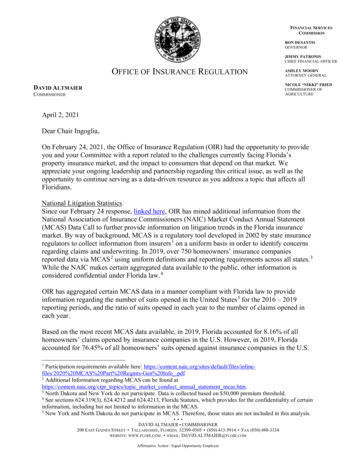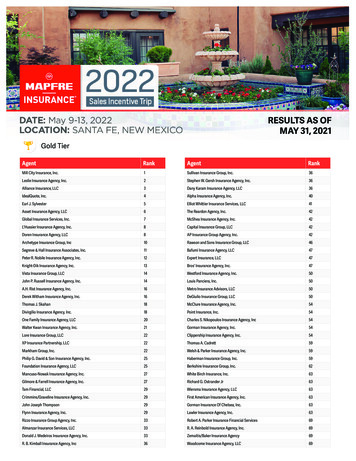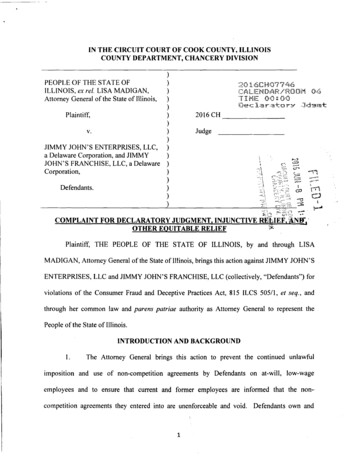
Transcription
FINANCIAL SERVICESCOMMISSIONRON DESANTISGOVERNORJIMMY PATRONISCHIEF FINANCIAL OFFICEROFFICE OF INSURANCE REGULATIONASHLEY MOODYATTORNEY GENERALNICOLE “NIKKI” FRIEDCOMMISSIONER OFAGRICULTUREDAVID ALTMAIERCOMMISSIONERApril 2, 2021Dear Chair Ingoglia,On February 24, 2021, the Office of Insurance Regulation (OIR) had the opportunity to provideyou and your Committee with a report related to the challenges currently facing Florida’sproperty insurance market, and the impact to consumers that depend on that market. Weappreciate your ongoing leadership and partnership regarding this critical issue, as well as theopportunity to continue serving as a data-driven resource as you address a topic that affects allFloridians.National Litigation StatisticsSince our February 24 response, linked here, OIR has mined additional information from theNational Association of Insurance Commissioners (NAIC) Market Conduct Annual Statement(MCAS) Data Call to further provide information on litigation trends in the Florida insurancemarket. By way of background, MCAS is a regulatory tool developed in 2002 by state insuranceregulators to collect information from insurers 1 on a uniform basis in order to identify concernsregarding claims and underwriting. In 2019, over 750 homeowners’ insurance companiesreported data via MCAS 2 using uniform definitions and reporting requirements across all states. 3While the NAIC makes certain aggregated data available to the public, other information isconsidered confidential under Florida law. 4OIR has aggregated certain MCAS data in a manner compliant with Florida law to provideinformation regarding the number of suits opened in the United States 5 for the 2016 – 2019reporting periods, and the ratio of suits opened in each year to the number of claims opened ineach year.Based on the most recent MCAS data available, in 2019, Florida accounted for 8.16% of allhomeowners’ claims opened by insurance companies in the U.S. However, in 2019, Floridaaccounted for 76.45% of all homeowners’ suits opened against insurance companies in the U.S.Participation requirements available here: efiles/2020%20MCAS%20Part%20Reqmts-Gen%20Info .pdf2Additional Information regarding MCAS can be found athttps://content.naic.org/cipr topics/topic market conduct annual statement mcas.htm.3North Dakota and New York do not participate. Data is collected based on 50,000 premium threshold.4See sections 624.319(3), 624.4212 and 624.4213, Florida Statutes, which provides for the confidentiality of certaininformation, including but not limited to information in the MCAS.5New York and North Dakota do not participate in MCAS. Therefore, those states are not included in this analysis.1 DAVID ALTMAIER COMMISSIONER200 EAST GAINES STREET TALLAHASSEE, FLORIDA 32399-0305 (850) 413-5914 FAX (850) 488-3334WEBSITE: WWW.FLOIR.COM EMAIL: DAVID.ALTMAIER@FLOIR.COMAffirmative Action / Equal Opportunity Employer
The results for 2019 are not an anomaly. As the chart below depicts, litigation trends in Floridahave been consistently many times higher than any other state.YearPercent of NationwideHomeowners’ Claims Opened 79.91%20198.16%76.45%Percent of Nationwide Homeowners’Suits Opened in FloridaThe MCAS data also includes a ratio of claims closed without payment to total claims closed anda ratio of suits opened to claims closed without payment. This data allows OIR to observe trendsin the context of other states. When comparing the number of claims closed without payment tototal claims closed, Florida trends along with the national average.However, Florida’s ratio of suits opened to claims closed without payment is eight times higherthan the next highest state at 27.75%. The state of Connecticut has the second highest ratio ofsuits opened to claims closed without payment at 3.4%. The next highest three states are NewJersey (2.45%), Rhode Island (2.23%), and Pennsylvania (1.82%).2
MethodologyTo examine the disparity between Florida and the other states, OIR analyzed the data fromseveral perspectives. First, we validated our methodology and results with MCAS staff at theNAIC.Next, because Florida’s domestic homeowners’ insurance market is heavily reliant on Floridaonly or regional insurers, we analyzed the litigation to claims ratio 6 of insurers operating inFlorida and other states to see if we detected a pattern of these insurers experiencing litigationhigher than their peers in other states; a potential indicator of, inter alia, claims handling issues.We did not detect any such systemic pattern that could explain this disparity.While we continue to explore these and other possibilities to explain the disparity, OIR does nothave a readily available explanation for Florida’s outlier status other than to simply state thatFlorida is experiencing far more claims-related litigation than the 47 other reporting states.The precise calculation is the “Number of suits opened during the period” divided by “Number of claims openedduring the period.”63
SolutionsWe appreciate the work of Chair Rommel on House Bill 305 that addresses property marketchallenges. To reaffirm and expand on OIR’s recommendations from February 24, and in light ofthe new data included in this report, we encourage the legislature to consider additional tortreform measures, including: Reform Florida’s One-Way Attorney’s Fees Statute 7. Floridians who have been wrongedby their insurance company should have an avenue to pursue damages via the judicialsystem. The one-way attorney’s fees statute provides an excellent venue for this to occur.However, the current one-way attorney’s fees statute provides an incentive for litigationto come before our judicial system that may not always be legitimate. The primary driverof this is the reality that plaintiffs need not necessarily prevail “substantially,” but onlywin at least one penny more than the insurer's initial offer in order to win attorney’s fees.We believe that adopting the attorney’s fees reforms enacted in 2019 in the AOBlegislation preserves important consumer protections, while providing a framework toensure that litigation brought against insurance companies is legitimate. To ensureconsumers continue to enjoy wide access to courts, any such revision, like the AOBreform, must not require claimants to pay attorney’s fees in cases not decided in theirfavor. Address the ramifications of the Joyce 8 decision regarding Contingency Fee Multipliers.Florida diverges from federal standards in its awarding of contingency fee multipliers.The Joyce decision highlights just how far Florida has diverged from the federal standard.After settling a dispute with their insurance company, Joyce received a settlement in theamount of 23,500. Their attorney calculated their lodestar attorney’s fees at over 38,000. On top of that, the trial court applied a contingency fee multiplier of 2.0.However, as the Fifth District Court of Appeal stated, the Joyce case “ was not acomplicated case. There was no esoteric legal issues or complicated factual disputes toresolve.” 9 The application of a multiplier in that case that “was not a complicated case”raises significant concerns that contingency fee multipliers will become the normalpractice, as opposed to what the Fifth District thought should be “rare and exceptional”cases. As Justice Scalia stated in his majority opinion in Burlington v. Dague, 505 U.S.557 (1992), the awarding of contingency fee multipliers could incentivize the filing ofmeritless cases for the sake of receiving a large attorney’s fees payout. Legislation thatcodifies the Fifth District Court of Appeal’s decision in Joyce by adopting a “rare andexceptional” framework for contingency fee multipliers could be effective in reducingthis incentive. Address the ramifications of the Sebo 10 decision regarding concurrent causation.The Sebo decision has incentivized roof claim solicitations based on the Florida SupremeCourt’s holding which applied the concurrent causation doctrine and held that insurancecoverage may exist when there are concurrent causes of loss and at least one cause isSection 627.428, Florida Statutes.Joyce v. Federated Nat’l Co., 228 So. 3d 1122 (Fla. 2017)9Joyce v. Federated Nat’l Co. v. Joyce, 179 So. 3d 492, 494 (Fla. 5th DCA 2015), decision quashed sub nom. Joycev. Federated Nat’l Ins. Co., 228 So. 3d 1122 (Fla. 2017)10 Sebo v. Am. Home Assurance Co., Inc., 208 So. 3d 694 (Fla. 2016)784
covered under the policy. Some stakeholders have argued that allowing insurers tomandate actual cash value coverage for roofs could address this incentive. While that islikely true, statutory language that specifically excludes “wear and tear” from concurrentcausation could also provide a disincentive for this behavior, while allowing consumersto keep replacement cost coverage for legitimate roof losses. Include provisions from the legislation recently enacted in the state of Texas. In 2017, theTexas Legislature passed House Bill 1774 broadening pre-suit notice and inspectionrequirements for property claims and addressing attorney’s fees. The law requires apotential claimant to notify its insurer of potential litigation at least 61 11 days beforefiling suit, regardless of the nature of the claim involved. The amount of attorney’s feesset forth in the demand must be based on the hours actually worked by the claimant’sattorney, as reflected in contemporaneously kept time records. The new law linksrecovery of attorney’s fees to the claimant’s trial recovery and initial demand by limitingan attorney’s fees recovery to the lesser of: (1) the amount of fees incurred by theclaimant in bringing an action; (2) the fees recoverable under another law; or (3) anamount based on the difference between the demand and the amount awarded in ajudgment. Under this final provision, the court would divide the amount to be awarded bythe amount of the initial demand to obtain a ratio. This ratio is then multiplied against theamount of fees actually incurred by the claimant. Thus, an excessive demand will resultin a substantial reduction of recoverable attorney’s fees, or no recovery at all; but areasonable or even low demand will result in a recovery of attorney’s fees in excess ofthe fees actually incurred. The new law also provides additional and very importantrestrictions on an attorney’s fees recovery. If an insurer is not given notice as required, acourt cannot award any attorney’s fees incurred after the insurer files a separate pleadingwith the Court. The separate pleading must be filed within 30 days of the date the insurerfiled its original answer. The outright bar on recovering attorney’s fees should serve as asubstantial incentive to follow the law.These solutions could substantially reduce the litigation associated with claims, bringing morecertainty into Florida’s property insurance market. Ultimately this will provide more stability inthe market and more rate stability for consumers. We are grateful for your thoughtfulconsideration of these ideas and we stand ready to assist your committee as you continue to workon this important issue.Sincerely,David AltmaierInsurance Commissioner11Under current Florida law, a claimant may file suit as early as the first notice of loss.5
JIMMY PATRONIS CHIEF FINANCIAL OFFICER ASHLEY MOODY ATTORNEY GENERAL NICOLE "NIKKI" FRIED COMMISSIONER OF AGRICULTURE. April 2, 2021 . Dear Chair Ingoglia, On February 24, 2021, the Office of Insurance Regulation (OIR) had the opportunity to provide you and your Committee with a report related to the challenges currently facing Florida's










